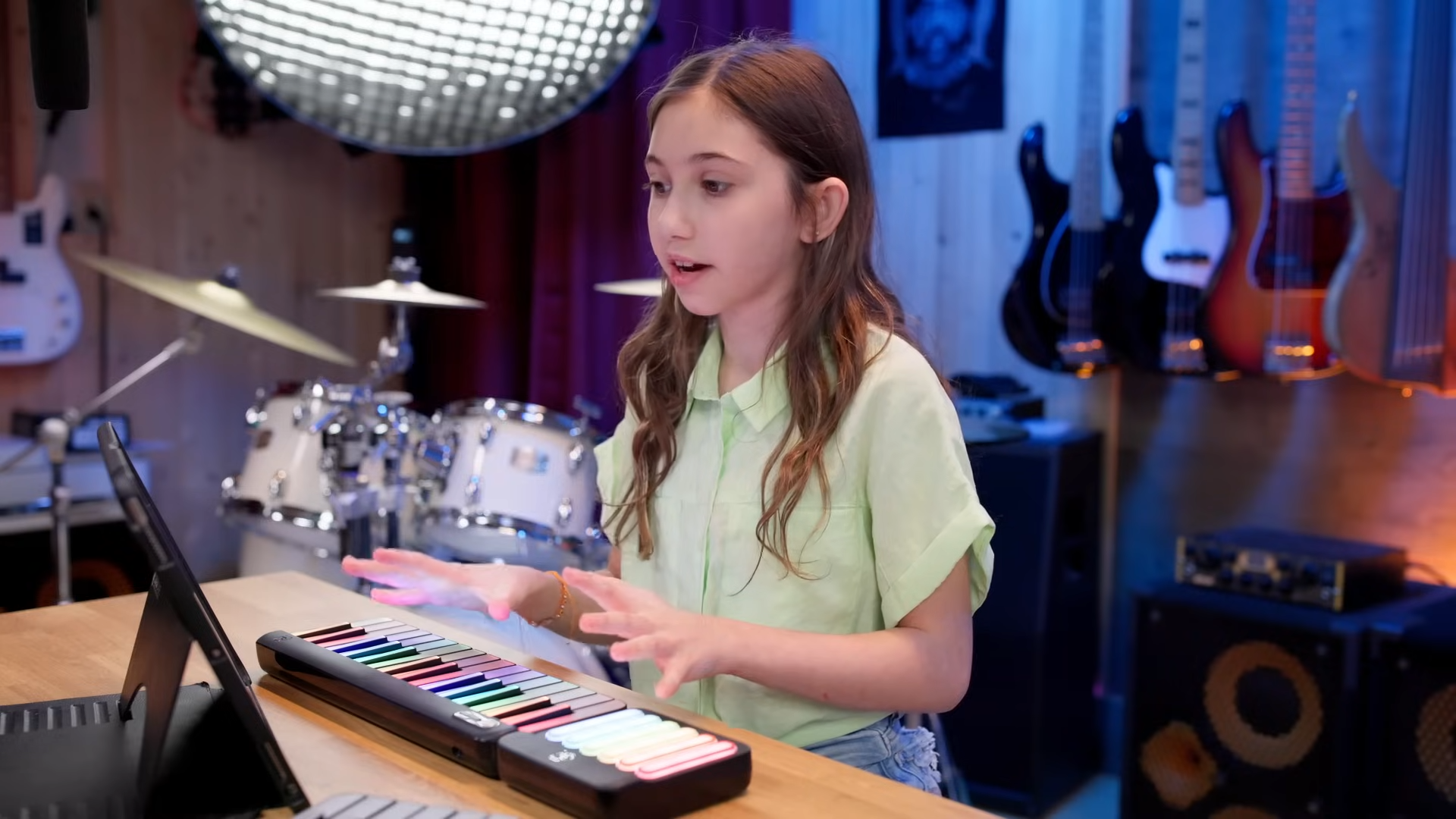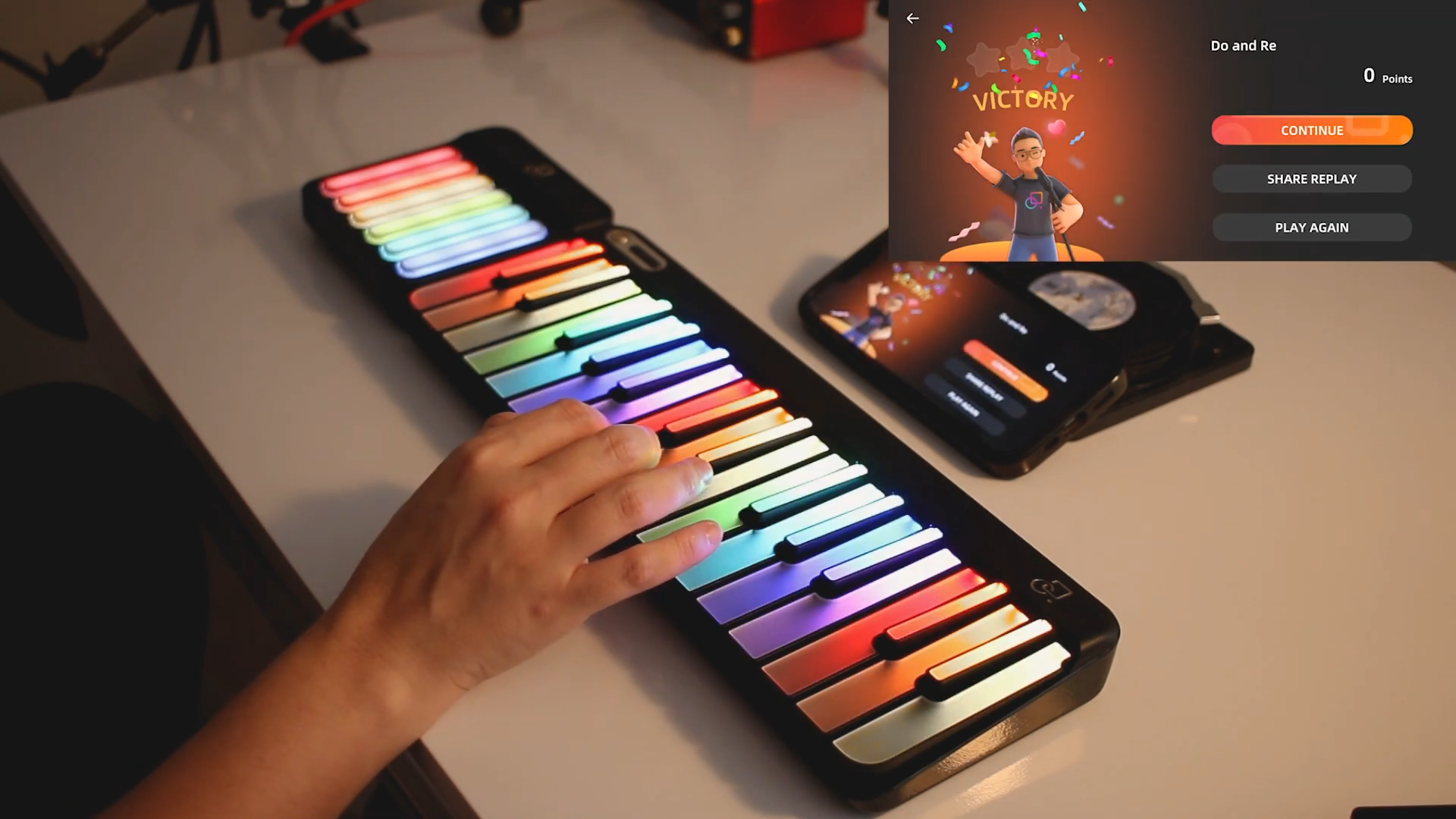
If you want to sound like a real player fast, start with chords. This guide shows you how to learn chords on a smart keyboard using simple shapes, guided lights, and short practice routines. You’ll also learn how to read chords, understand keyboard notes for beginners, and build a handful of beginner piano chords you can use in almost any song.
Chords are the backbone of songs. Learn a few flexible keyboard chords and you can play pop, worship, film themes, and lo‑fi progressions without learning pages of notation. On a smart instrument, lights show the notes you need, the app waits when you miss, and you get instant feedback. That’s why learning chords on keyboard is the fastest way to sound musical.
Before chords, you only need one map:
That’s enough to place your hands and build your first chord keyboard shapes.
Chord symbols tell you what notes to stack. Here’s the 80/20:
If you’re new to how to read chords, think of each chord as a shape you can memorize by look and feel, not just theory.
A good smart instrument makes how to learn chords on a smart keyboard feel natural:
Try a guided example on a modern smart keyboard and notice how quickly your hands memorize shapes.
Use this simple method for the first two weeks:
Step 1 — Learn the six core shapes
C, F, G, Am, Dm, Em. These beginner piano chords cover hundreds of songs.
Step 2 — Use lights + count intervals
When C lights up, say “1‑3‑5” (C‑E‑G). For Am, say “1‑flat‑3‑5” (A‑C‑E). Speaking the intervals teaches your ear and hand together.
Step 3 — Right hand first, then add left‑hand root
Play the chord with your right hand; add the single bass note (root) in your left. That’s the simplest way to sound full.
Step 4 — Loop hard jumps
If F→G is messy, loop just those two for 60 seconds. The smart loop saves time.
Step 5 — Apply to a progression
Use I–V–vi–IV (C–G–Am–F). Follow lights at 70% speed, then bump by 5–10% when you can play cleanly three times.
Repeat daily in 10–15 minute sessions. You’ll feel real progress in a week.
Right‑hand finger numbers: 1=thumb, 2=index, 3=middle, 4=ring, 5=pinky.
|
Chord |
Notes |
Root Position Fingering (RH) |
First Inversion |
Second Inversion |
|
C |
C‑E‑G |
1‑3‑5 |
E‑G‑C → 1‑2‑5 |
G‑C‑E → 1‑3‑5 |
|
F |
F‑A‑C |
1‑3‑5 |
A‑C‑F → 1‑2‑5 |
C‑F‑A → 1‑3‑5 |
|
G |
G‑B‑D |
1‑3‑5 |
B‑D‑G → 1‑2‑5 |
D‑G‑B → 1‑3‑5 |
|
Am |
A‑C‑E |
1‑2‑5 or 1‑3‑5 |
C‑E‑A → 1‑2‑5 |
E‑A‑C → 1‑3‑5 |
|
Dm |
D‑F‑A |
1‑2‑4 or 1‑3‑5 |
F‑A‑D → 1‑2‑5 |
A‑D‑F → 1‑3‑5 |
|
Em |
E‑G‑B |
1‑2‑4 or 1‑3‑5 |
G‑B‑E → 1‑2‑5 |
B‑E‑G → 1‑3‑5 |
These three are your best return on time. Use the metronome and follow‑lights.
As you rotate these, you’ll hear how many songs are just chords on keyboard moving in familiar patterns.
Big jumps waste time. Inversions keep the same notes but rearranged to the nearest shape:
How to practice inversions: Set your smart keyboard to loop C–G–Am–F. Each pass, choose the closest inversion to the last chord. Lights will still guide notes; you choose the nearby shape.
Even perfect shapes can sound flat without rhythm. Try these patterns over 4 counts:
Use the app’s metronome at 70–80 BPM first. Smooth rhythm makes simple keyboard chords sound pro.
Week 1 — Shapes & timing (15 min/day)
Week 2 — Inversions (15–20 min/day)
Week 3 — Add seventh & sus flavors (20 min/day)
Week 4 — Rhythm & left hand (20–25 min/day)
By day 30 you’ll have real muscle memory and can confidently say you know how to learn chords on a smart keyboard the right way.
You don’t need years of lessons to sound musical. A few shapes, a metronome, and smart guidance will take you a long way. If you’re ready to try this workflow, explore a light‑guided smart keyboard or browse more resources. Start slow, follow the lights, and let your ears confirm what your hands are learning.
Use follow‑lights to see shapes, loop the hardest transitions, and start with the six core triads (C, F, G, Am, Dm, Em). Add rhythm once changes are clean.
No. If you know how to read chords (symbols like C, Am, G7), you can play hundreds of songs. Add notation later if you want.
Yes. Get triads and smooth inversions first; add maj7, 7, and sus once your timing is steady.
Even compact keyboards work for chords. If you want fuller left‑hand bass patterns later, more keys help—but they’re not required at the start.
Yes. One‑tap chords or chord pads let your left hand supply harmony while your right plays melody—the easiest entry to accompaniment.
Leer más

MIDI Controller vs Smart Keyboard for Beginners
If you’re just starting out, It’s easy to mix up a MIDI controller with a smart keyboard. Both have piano‑style keys. Both connect to phones, tablets, and laptops. Both can help you make music. But...

How to Follow LED Lights on Piano: Beginner’s Guide
If you’ve just unboxed a piano with lights and you’re wondering how to follow LED lights on piano without picking up bad habits, you’re in the right place. Light‑guided keyboards are designed to sh...